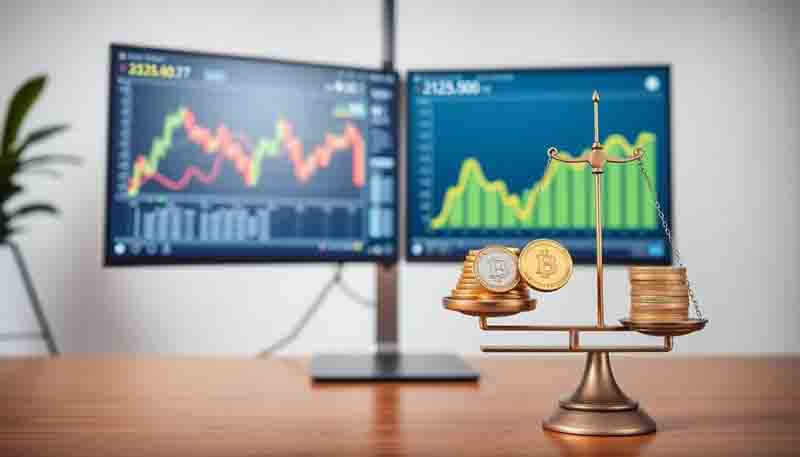Balancing Crypto and Precious Metals in Your Portfolio
Note: This post may contain affiliate links, and we may earn a commission (with No additional cost for you) if you purchase via our link. See our disclosure for more info. The gold and crypto world is constantly changing. This is not financial, investment, legal, or professional advice. So, please verify the information on the gold and cryptocurrency provider’s websites.
As you consider diversifying your investment portfolio, you've likely encountered the buzz surrounding cryptocurrencies and the enduring appeal of precious metals. But how do you strike the right balance between these seemingly disparate assets? While crypto offers the allure of high returns and cutting-edge technology, gold and other metals provide a time-tested hedge against economic uncertainty. The key lies in understanding how these assets complement each other and how to leverage their unique characteristics to your advantage. By exploring the intricacies of portfolio allocation and risk management, you'll uncover strategies that can help you navigate the volatile world of crypto while maintaining the stability of precious metals.
Key Takeaways
- Allocate 5-10% of your portfolio to precious metals for stability and 1-5% to cryptocurrencies for growth potential.
- Diversify crypto holdings with 50% Bitcoin, 30% Ethereum, and 20% altcoins to balance risk and reward.
- Implement regular rebalancing, at least annually, to maintain desired asset allocation and manage risk.
- Use dollar-cost averaging for crypto investments to mitigate volatility risks and smooth out price fluctuations.
- Monitor performance regularly and adjust allocations based on market conditions and your risk tolerance.
Understanding Crypto and Gold Markets
Diving into the world of crypto and gold markets reveals stark contrasts in volatility, market size, and investor perception. The crypto market, exemplified by Bitcoin, experiences daily price swings often exceeding 10%, while gold's movements typically hover around 1-2%. This volatility difference reflects the maturity and stability of each asset class.
Gold's $11 trillion market capitalization dwarfs Bitcoin's $500 billion, highlighting the vast disparity in investor confidence and market penetration. As you develop your investment strategy, consider how these market sizes might impact liquidity and long-term stability.
- Risk profile: Cryptocurrencies offer potential for high returns but carry significant risks.
- Diversification: Gold's stability can balance crypto's volatility in a portfolio.
- Intrinsic value: Gold has industrial applications, while crypto lacks tangible value.
When crafting your investment approach, weigh the historical performance of both assets. Gold's 40% appreciation over five years pales in comparison to Bitcoin's 300% gains.
However, gold's centuries-long track record as a safe-haven asset during economic turmoil contrasts with crypto's sensitivity to regulatory changes and market sentiment. Your risk tolerance and financial goals should guide your allocation between these distinct asset classes.

Portfolio Allocation Strategies
Precision in portfolio allocation forms the cornerstone of a successful crypto and precious metals investment strategy. When diversifying your investment, consider allocating 5% to 10% of your total assets to precious metals, with the remainder distributed across various crypto assets.
A strategic allocation for your crypto portfolio might include 50% Bitcoin, 30% Ethereum, and 20% altcoins, balancing growth potential with stability.
To optimize your portfolio's performance, follow these key steps:
- Implement regular rebalancing, at least annually, to maintain alignment with your investment goals.
- Utilize dollar-cost averaging for cryptocurrency investments to mitigate volatility risks.
- Maintain a consistent percentage allocation to precious metals for portfolio stability.
- Diversify within your crypto holdings across sectors like DeFi, NFTs, and stablecoins.
Risk Management Techniques
Investors in the volatile world of crypto and precious metals must employ robust risk management techniques to protect their portfolios. To effectively manage risk, consider implementing stop-loss orders for both asset classes. These orders automatically sell your assets when they reach a predetermined price, limiting potential losses during market downturns.
Regularly rebalancing your portfolio is vital for maintaining a diversified allocation. Aim to keep 5% to 10% of your investments in precious metals alongside your crypto holdings. This strategy helps manage risk and aligns with your investment goals.
Understanding your risk tolerance is essential; if you're risk-averse, you might prefer a higher allocation to stable assets like precious metals over volatile cryptocurrencies.
Maintaining a diversified crypto portfolio that includes various asset classes can reduce overall risk exposure. By spreading your investments across different categories, you mitigate the impact of poor performance in any single investment.
Consistently analyze market conditions and compare your portfolio's performance against benchmarks. This practice allows for timely adjustments to your investment strategy, helping you manage risks associated with both crypto volatility and precious metal price fluctuations.

Market Volatility Considerations
Steering through the turbulent waters of market volatility requires a keen understanding of how cryptocurrencies and precious metals react to economic shifts.
As you navigate these markets, consider the following factors to help mitigate the risk in your investment portfolio:
- Volatility differences: Crypto investments often experience dramatic price swings, with Bitcoin fluctuating over 10% daily. In contrast, precious metals like gold typically move within 1-2% daily, offering a more stable option.
- Safe-haven status: During economic uncertainty, precious metals often act as safe and secure assets, appreciating when cryptocurrencies face downturns due to market corrections or regulatory news.
- Low correlation: Cryptocurrencies and precious metals generally have a low correlation, allowing you to diversify your crypto holdings and reduce overall portfolio risk.
- Historical performance: Gold has shown a positive trend during major stock market declines in recent years, while cryptocurrencies often face increased volatility.
Long-Term Investment Perspectives
A balanced approach to long-term investing in crypto and precious metals can greatly enhance your portfolio's resilience and growth potential. By diversifying your assets across these two classes, you're reducing the impact of market volatility on your overall investment. This strategy aligns with long-term financial goals while providing both stability and opportunities for growth.
Consider allocating 5-10% of your portfolio to precious metals, which act as a hedge against inflation and economic downturns. Your investment in the crypto space can be adjusted based on your risk tolerance and market conditions. Here's a simplified breakdown:
| Asset Type | Allocation Range | Benefits |
|---|---|---|
| Precious Metals | 5-10% | Stability, Inflation Hedge |
| Cryptocurrencies | 1-5% | High Growth Potential |
| Traditional Assets | 85-94% | Diverse Market Exposure |
Your investment horizon plays a significant role in this strategy. As you approach your financial goals, you may want to shift towards more stable assets. Regular portfolio reviews and rebalancing are essential to maintain your desired allocation and adapt to changing market dynamics. Remember, the low correlation between cryptocurrencies and precious metals can help reduce overall portfolio risk and improve long-term performance stability.

Rebalancing and Performance Monitoring
To maintain a balanced portfolio of cryptocurrencies and precious metals, you'll need to conduct periodic assessments and adjust your asset allocations accordingly.
You should regularly track the performance of your investments, comparing them against predetermined benchmarks to gauge their effectiveness.
Periodic Portfolio Assessment
As your crypto and precious metals portfolio evolves, regular assessment becomes essential for maintaining your desired asset allocation.
Periodic evaluation helps you identify imbalances caused by market fluctuations and guarantees your investments remain aligned with your financial goals.
To effectively manage your portfolio, consider implementing the following assessment strategies:
- Establish a review schedule: Set up quarterly or bi-annual assessments to evaluate your portfolio's performance and make timely adjustments.
- Compare against benchmarks: Monitor your investments' performance relative to major cryptocurrency indices and precious metal prices to gauge effectiveness.
- Utilize tracking tools: Employ portfolio apps or analytics platforms to access real-time data and market trends for informed decision-making.
- Rebalance as needed: Adjust your asset allocation by taking profits from overperforming investments and reallocating to underrepresented assets.

Adjusting Asset Allocations
Regular rebalancing and performance monitoring are vital components of maintaining a healthy crypto and precious metals portfolio. To keep your investments aligned with your financial goals and risk tolerance, it's essential to periodically evaluate and adjust your asset allocations. A balanced crypto portfolio typically includes 5-10% in precious metals, serving as a stabilizing hedge during economic downturns.
To effectively manage your portfolio:
- Conduct thorough research on market conditions and trends
- Utilize portfolio management tools to track performance
- Set benchmarks for each asset class
- Compare cryptocurrency performance against precious metals
Remember, diversification means spreading your investments across different assets. As cryptocurrencies can be highly volatile, it's important to adjust your allocations based on current market conditions.
Precious metals often appreciate during market crises, making them a valuable component of your investment strategy. Your investment experience will grow as you actively monitor and rebalance your portfolio.
Tracking Investment Performance
For effective portfolio management, tracking investment performance is essential when balancing crypto and precious metals. Regularly monitoring both asset classes allows you to identify trends and make informed rebalancing decisions.
By utilizing portfolio tracking apps, you'll gain real-time insights into value fluctuations, enabling prompt reactions to market changes.
To enhance your portfolio that aligns with your financial goals, consider implementing these strategies:
- Set predetermined thresholds for asset performance, such as adjusting allocations if any asset deviates by 5-10% from its target weight.
- Analyze historical performance data to determine ideal rebalancing frequencies, with quarterly assessments often recommended.
- Compare cryptocurrency performance against precious metals to highlight necessary adjustments, especially during periods of high crypto volatility.
- Utilize portfolio tracking apps for real-time monitoring of digital assets and precious metals.
Frequently Asked Questions
How Much Precious Metals Should Be in Your Portfolio?
Financial experts suggest allocating 5-10% of your portfolio to precious metals. This gold allocation strategy can provide diversification benefits and act as an inflation hedge.
You should consider a mix of gold, silver, and platinum investments to maximize long-term value. As market volatility increases, precious metals often retain their worth, offering stability.
How Should I Balance My Crypto Portfolio?
To balance your crypto portfolio, you'll need to evaluate your risk tolerance and market trends.
Start by allocating 40% to established coins like Bitcoin and Ethereum for long-term growth.
Diversify with 20% in altcoins for exposure to emerging tech.
Use dollar-cost averaging for 20% to mitigate crypto volatility.
Allocate 10-30% to speculative assets based on your risk appetite.
Regularly rebalance your portfolio to maintain your target asset allocation.
This investment strategy offers diversification benefits while aligning with your financial goals.
What Percentage of My Portfolio Should Be Crypto?
To determine your crypto portfolio percentage, consider your risk tolerance, investment timeframes, and overall financial goals.
Generally, experts suggest allocating 5-10% of your portfolio to cryptocurrencies. However, if you're comfortable with high volatility and have a long-term outlook, you might increase this to 20%.
Assess crypto market trends and growth potential, but don't overlook diversification strategies.
Remember to factor in tax implications and regularly rebalance your portfolio.
Ultimately, your allocation should align with your personal financial situation and risk appetite.
Should I Rebalance My Crypto Portfolio?
You should regularly rebalance your crypto portfolio to manage risk and capitalize on market trends.
Consider your investment timeframes and risk tolerance when adjusting allocations. Rebalancing helps maintain diversification benefits, mitigating the impact of market volatility.
Be mindful of psychological factors that may influence your decisions, and stay informed about regulatory considerations.
Implement a systematic approach, using tools to track performance and identify rebalancing opportunities.
This strategy can optimize your portfolio's potential returns while aligning with your long-term financial goals.
Conclusion
By balancing crypto and precious metals in your portfolio, you'll create a more resilient investment strategy. Remember, diversification is key: a study by the World Gold Council found that portfolios with a 5-10% allocation to gold have historically outperformed those without. As you navigate market volatility, regularly reassess your asset mix and risk tolerance. Stay informed about market trends, and don't hesitate to seek professional advice when needed. With careful planning and monitoring, you'll be better positioned to achieve your long-term financial goals.













